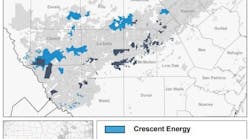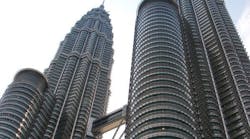New subsea technology, horizontal drilling, and the existing North Sea infrastructure allowed BP Exploration Operating Co. Ltd. to develop the Newsham field, a small 1967 gas discovery.
BP says cost of the single-well subsea development in Block 48/7a was £25 million ($39 million). BP EOC Ltd. holds 100% interest and started producing on June 6 at a rate of 31 MMscfd.
Estimated originally in place recoverable reserves are 1.36 billion cu m (48 bcf). The development is in 30 m of water (98 ft) and the subsea well is tied-back to the West Sole pipeline system.
The development included:
- Converting a mudline suspension system to a subsea wellhead
- Deploying a horizontal subsea tree
- Producing gas from a subsea wellhead
- Deploying the subsea tree from a jack up drilling rig
- Installing an over-trawlable wellhead protection structure.
Field development
The Newsham gas field, about 5 km (3 miles) from West Sole Alpha platform, was discovered in 1967 ( Fig. 1 [31224 bytes]). Texaco Ltd. drilled two appraisal wells in 1988 and 1989. BP obtained a stake and became operator in the block in 1994 and in January 1995 obtained 100% interest in the block.
BP says it evaluated various development scenarios for the field, including extended reach drilling from the West Sole WA platform. But it decided to re-enter Texaco's Well 48/7a-9 and drill a sidetrack with an 1,800 m (5,900 ft), 6-in. horizontal lateral through the reservoir.
The work included converting the existing mudline suspension on Well 48/7a-9 to a subsea wellhead with a subsea tree and making major modifications to the WA platform.
Fast track
BP indicates that the fast-track nature of the project was one of the main challenges. The overall project was scheduled for only 13 months, from concept to first gas.
BP selected FMC Corp. U.K. Ltd.'s 135/8-in., 5,000 psi horizontal tree and wellhead conversion system for the following reasons:
- 3-month delivery time
- Rental basis of the high-pressure riser system, which saved significant costs compared to purchasing a new riser system.
- Performance criteria in the risk/reward basis contract that substantially determined FMC's profit margin
- Reduced workover costs because a horizontal tree allows well work with the tree in place ( Fig. 2 [83848 bytes]).
Design
Conversion to a subsea well head from a mudline suspension required a tie-back to the existing 133/8-in. and 95/8-in. mudline hangers.
The 135/8-in. subsea wellhead ties into the 133/8-in. hanger and is made rigid to the 30-in. conductor, through a production guide base (PGB), with various adjustment rings and clamps.
The 95/8-in. subsea casing hanger ties into the 95/8-in. mudline hanger and includes an adjustment sub to ensure the correct spacing.
The old well had an ABB Vetco Gray U.K. Ltd. mudline suspension system set 5-ft below the mudline. Because this left very little room for the conversion equipment, BP held intensive design discussions with FMC and Vetco that resulted in Vetco designing a new adjustment sub specifically for the reduced clearance.
An onshore trial, at FMC's Dunfermline yard, of the complete conversion system replicated offshore conditions. Divers and offshore personnel, who would carry out the complex conversion procedures, also trained at this facility.
FMC also provided a step-by-step computer animation of the process. BP says this animation and the onshore training, proved invaluable for eliminating downtime during offshore operations.
Drilling
Reading & Bates U.K. Ltd.'s F.G. McClintock jack up was used to re-enter Well 48/7a-9. The side track in the 81/2-in. hole was started at about 380 m (1,250 ft) above the reservoir. Inclination from vertical was built at 5°/30 m to 65° at the 7-in. casing setting depth, just above the reservoir.
BP indicates that an unusual feature was the need to cut, pull, and replace the existing 95/8-in. casing. This was necessary because the subsea tree/wellhead design did not include any access to vent the 95/8-in. by 133/8-in. annulus. Pressure build up in this annulus when the well was brought on stream could possibly collapse the casing.
The 95/8-in. casing was cut above the sidetrack point and replaced with a combination heavy-wall 95/8-in. and 7-in. casing string.
BP targeted the 6-in. horizontal section at a 30-m thick Aeolian sand unit that is the most productive in the field. Hole angle was built to 90°, at 5°/30 m. Steerable turbines and diamond bits drilled the 1,400 m (4,600 ft) horizontal lateral in the reservoir.
Hole spiraling was a problem in earlier wells in the area and BP was particularly concerned about it prior to spudding the well. BP required a nonspiral hole for a good ultrasonic (UBI) log run to detect fractures.
Because of increased steering difficulties in the last few hundred meters of hole, BP called TD early after the lateral exited the top of the reservoir.
BP indicated that the ultrasonic (UBI) log showed a very good hole with no spiral. The image quality was such that BP could see a small groove on the lower side of the hole, caused by drill pipe sliding along the hole.
Wellhead conversion
After running a 41/2-in. predrilled liner, BP temporarily plugged the well before carrying out the FMC 135/8-in. subsea conversion.
Air divers from the rig did intensive diving operations. BP says the surprisingly good weather conditions for February in the North Sea avoided having to call in a diver support vessel. This saved about £500,000.
The wellhead conversion phase required 7 days to complete.
Subsea completion
Deck loading and space limitations on the jack up prevented the 25 metric ton tree from being placed down on the deck of the rig. Therefore, BP fully function tested the tree at dockside prior to delivering it on a supply boat.
At the site, the supply boat backed under the rig's cantilever so that the tree could be lifted off and suspended above the Texas deck.
After hooking up the tree to the control umbilical, it was run on drill pipe. The suspension plugs were retrieved after successfully testing the tree and running the 16 in., high-pressure riser and blowout preventers.
BP completed the well with 41/2-in. tubing, nitrogen lifted the well, and cleaned the well with a well-test package on the rig.
After testing, the tree was plugged with an internal wire line plug, high-pressure cap, and debris cap. Meanwhile, divers hooked up the platform control system and pipeline spool pieces to the tree and commissioned the control system.
Well completion required 98 days compared to 95 days in the plan.
BP said some useful lessons were learned throughout the operations and in general the performance was very good, particularly bearing in mind that the offshore operations were completed during the winter months and included many weather sensitive steps.
Copyright 1996 Oil & Gas Journal. All Rights Reserved.

